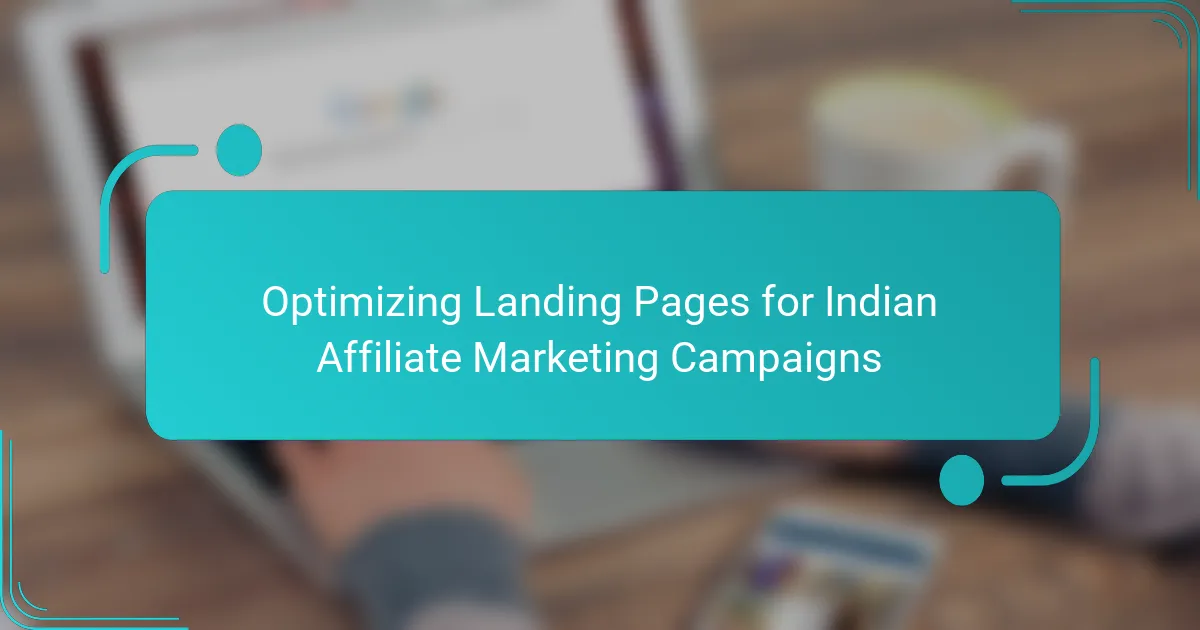Optimizing landing pages for Indian affiliate marketing requires a deep understanding of local consumer preferences and behaviors. By focusing on clear messaging, engaging visuals, and a seamless user experience, marketers can significantly enhance conversion rates. Leveraging the right tools for performance tracking and content optimization is essential to drive successful affiliate sales in this diverse market.

How to Optimize Landing Pages for Indian Affiliate Marketing?
To optimize landing pages for Indian affiliate marketing, focus on creating content that resonates with the local audience and drives conversions. This involves tailoring your messaging, visuals, and user experience to meet the preferences and behaviors of Indian consumers.
Focus on Localized Content
Localized content is crucial for engaging Indian audiences effectively. Use regional languages, cultural references, and local examples to make your message relatable. Highlight products or services that cater specifically to Indian needs and preferences.
Incorporate local trends and festivals into your content strategy. For instance, during Diwali, emphasize promotions or products that align with the festive spirit, which can significantly boost engagement and conversion rates.
Utilize High-Quality Visuals
High-quality visuals enhance user experience and can lead to higher conversion rates. Use images and videos that reflect the diversity and vibrancy of Indian culture. Ensure visuals are relevant to the products being promoted and resonate with the target demographic.
Consider using infographics or videos to explain complex products or services. These formats can simplify information and make it more digestible, catering to various audience preferences.
Implement Clear Call-to-Actions
Clear and compelling call-to-actions (CTAs) are essential for guiding users towards desired actions. Use action-oriented language that encourages clicks, such as “Get Your Discount Now” or “Join Our Community Today.” Position CTAs prominently on the page.
A/B testing different CTA placements and wording can help identify what resonates best with your audience. Ensure that CTAs stand out visually, using contrasting colors and larger fonts to draw attention.
Enhance Page Load Speed
Page load speed significantly impacts user experience and conversion rates. Aim for a load time of under three seconds to reduce bounce rates. Optimize images, leverage browser caching, and minimize HTTP requests to enhance speed.
Regularly test your landing page speed using tools like Google PageSpeed Insights. Address any issues promptly to maintain an optimal user experience, especially on mobile devices where speed is critical.
Mobile Optimization Strategies
With a large portion of Indian users accessing the internet via mobile devices, optimizing for mobile is essential. Ensure your landing page is responsive, adjusting seamlessly to different screen sizes and orientations.
Prioritize mobile-friendly design elements such as larger buttons, simplified navigation, and minimal text input. Consider using mobile-specific features like click-to-call buttons to enhance user interaction and convenience.

What are the Best Practices for Indian Affiliate Marketing Landing Pages?
Effective Indian affiliate marketing landing pages focus on clear messaging, user engagement, and optimized content to drive conversions. Implementing best practices can significantly enhance user experience and increase the likelihood of affiliate sales.
SEO Keyword Integration
Integrating relevant SEO keywords is crucial for improving visibility in search engines. Identify keywords that resonate with your target audience and incorporate them naturally into your landing page content, headings, and meta descriptions.
Use tools like Google Keyword Planner or Ubersuggest to find popular search terms in India. Aim for a mix of short-tail and long-tail keywords to capture diverse search intents. Avoid keyword stuffing, as it can negatively impact readability and SEO performance.
User-Centric Design
A user-centric design prioritizes the needs and preferences of visitors, enhancing their experience on the landing page. Ensure that your layout is clean, mobile-friendly, and easy to navigate, as a significant portion of Indian users access the internet via smartphones.
Utilize clear calls-to-action (CTAs) and strategically place them throughout the page. A/B testing different designs can help identify which elements resonate best with your audience, leading to higher conversion rates.
Social Proof and Testimonials
Incorporating social proof, such as testimonials and user reviews, builds trust and credibility with potential customers. Highlight positive feedback from previous users to reassure visitors about the quality of the products or services being promoted.
Consider using star ratings, case studies, or video testimonials to make the social proof more engaging. Displaying recognizable brands or partnerships can further enhance trust and encourage conversions on your affiliate landing page.

Which Tools Can Help Optimize Landing Pages?
Several tools can significantly enhance the effectiveness of landing pages for Indian affiliate marketing campaigns. Utilizing the right tools allows marketers to track performance, conduct keyword research, and test variations to improve conversion rates.
Google Analytics for Performance Tracking
Google Analytics is essential for tracking the performance of landing pages. It provides insights into user behavior, traffic sources, and conversion rates, helping marketers understand what works and what doesn’t.
To effectively use Google Analytics, set up goals that align with your campaign objectives. Monitor metrics such as bounce rate, average session duration, and conversion rates to identify areas for improvement.
Regularly reviewing these metrics can help you make data-driven decisions, ensuring your landing pages are optimized for maximum engagement and conversions.
SEMrush for Keyword Research
SEMrush is a powerful tool for conducting keyword research, crucial for optimizing landing pages. It helps identify high-traffic keywords relevant to your niche, enabling you to tailor content that attracts more visitors.
Utilize SEMrush to analyze competitors’ keywords and discover gaps in your own strategy. Focus on long-tail keywords that have lower competition but higher intent, which can lead to better conversion rates.
Incorporate these keywords naturally into your landing page content, meta descriptions, and headings to improve search engine visibility and relevance.
Unbounce for A/B Testing
Unbounce is a leading platform for A/B testing landing pages, allowing marketers to compare different versions and determine which performs better. This tool is vital for optimizing elements like headlines, images, and calls to action.
When using Unbounce, create variations of your landing page and split your traffic between them. Analyze the results based on conversion rates to identify the most effective design and content.
Regular A/B testing can lead to incremental improvements, ultimately boosting your campaign’s overall performance and return on investment.

What Metrics Should You Track for Landing Page Success?
To optimize landing pages for Indian affiliate marketing campaigns, focus on key metrics like conversion rate, bounce rate, and average time on page. Tracking these metrics helps identify areas for improvement and enhances overall campaign effectiveness.
Conversion Rate Analysis
Conversion rate is the percentage of visitors who complete a desired action, such as making a purchase or signing up for a newsletter. For Indian affiliate marketing, a conversion rate of 2-5% is often considered average, but this can vary based on the niche and target audience.
To improve conversion rates, consider A/B testing different elements on your landing page, such as headlines, images, and call-to-action buttons. Ensure that your offers are relevant and appealing to your target demographic, as this can significantly impact conversion outcomes.
Bounce Rate Monitoring
Bounce rate measures the percentage of visitors who leave your landing page without interacting further. A high bounce rate, typically above 50%, may indicate that your content is not engaging or relevant to your audience.
To reduce bounce rates, ensure your landing page loads quickly and is mobile-friendly, as many users in India access the internet via smartphones. Additionally, use clear and compelling headlines to capture attention and encourage visitors to explore further.
Average Time on Page
Average time on page indicates how long visitors stay on your landing page before navigating away. A longer time on page often suggests that users find your content valuable and engaging, which can lead to higher conversion rates.
To increase average time on page, provide high-quality, informative content that addresses your audience’s needs. Incorporate multimedia elements like videos or infographics to keep users engaged, and consider adding internal links to related content to encourage further exploration.

How to Create Effective A/B Tests for Landing Pages?
Creating effective A/B tests for landing pages involves comparing two or more versions to determine which performs better in achieving specific goals. Focus on testing elements like headlines, images, and call-to-action buttons to enhance conversion rates.
Define Clear Objectives
Establishing clear objectives is crucial for successful A/B testing. Identify what you want to achieve, such as increasing sign-ups, boosting sales, or improving click-through rates. Having specific goals helps in designing tests that yield actionable insights.
For example, if your goal is to increase newsletter sign-ups, your A/B test could compare two different sign-up forms. One might feature a simple design, while the other includes additional incentives like a free e-book. This clarity will guide your testing process and help you measure success accurately.
Choose the Right Metrics
Selecting appropriate metrics is essential for evaluating the effectiveness of your A/B tests. Common metrics include conversion rates, bounce rates, and average time on page. Choose metrics that align with your objectives to ensure relevant insights.
For instance, if your objective is to increase sales, focus on conversion rates and revenue generated. If you’re testing a landing page aimed at generating leads, track how many visitors fill out a form. This targeted approach will provide clearer data for decision-making.
Test One Element at a Time
To accurately assess the impact of changes, test one element at a time. This could be a headline, image, or call-to-action button. Isolating variables allows you to pinpoint what specifically drives changes in user behavior.
For example, if you change both the headline and the button color simultaneously, it becomes difficult to determine which change influenced the results. By testing one element, you can confidently attribute any performance differences to that specific change.
Analyze Results and Iterate
After running your A/B tests, analyze the results to determine which version performed better. Look for statistically significant differences to ensure your findings are reliable. Use tools like Google Analytics or specialized A/B testing software to assist in this analysis.
Once you identify the winning version, implement the changes and consider further testing. Continuous iteration is key to optimizing landing pages effectively. For instance, after improving the sign-up form, you might test different incentives to further boost conversions.
